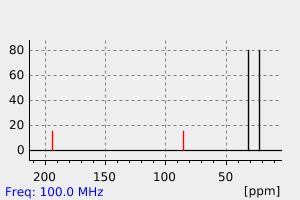3,3-二氯丁烷-2-酮 | 2648-57-9
中文名称
3,3-二氯丁烷-2-酮
中文别名
——
英文名称
3,3-Dichloro-2-butanone
英文别名
3,3-dichlorobutan-2-one;3,3-Dichlor-2-butanon;3,3-dichloro-butan-2-one;Methyl-(1.1-dichlor-aethyl)-keton;3,3-Dichlor-butan-2-on;Methyl-(α.α-dichlor-aethyl)-keton
CAS
2648-57-9
化学式
C4H6Cl2O
mdl
——
分子量
140.997
InChiKey
WBVOVRCGXKWAQT-UHFFFAOYSA-N
BEILSTEIN
——
EINECS
——
-
物化性质
-
计算性质
-
ADMET
-
安全信息
-
SDS
-
制备方法与用途
-
上下游信息
-
文献信息
-
表征谱图
-
同类化合物
-
相关功能分类
-
相关结构分类
物化性质
-
沸点:30 °C(Press: 30 Torr)
-
密度:1.231±0.06 g/cm3(Predicted)
计算性质
-
辛醇/水分配系数(LogP):1.5
-
重原子数:7
-
可旋转键数:1
-
环数:0.0
-
sp3杂化的碳原子比例:0.75
-
拓扑面积:17.1
-
氢给体数:0
-
氢受体数:1
SDS
反应信息
-
作为反应物:描述:参考文献:名称:Faworski, Journal fur praktische Chemie (Leipzig 1954), 1895, vol. <2>51, p. 555摘要:DOI:
-
作为产物:描述:参考文献:名称:The Preparation of α,α-Dichloro Ketones1摘要:DOI:10.1021/jo01018a018
文献信息
-
Copper(I)-Catalyzed Addition of Grignard Reagents to in Situ-Derived <i>N</i>-Sulfonyl Azoalkenes: An Umpolung Alkylation Procedure Applicable to the Formation of Up to Three Contiguous Quaternary Centers作者:John M. Hatcher、Don M. ColtartDOI:10.1021/ja100932q日期:2010.4.7that has considerable potential with regard to catalysis and the direct incorporation of functionality not amenable to the use of enolate chemistry. Herein, we describe the first Cu(I)-catalyzed addition of Grignard reagents to in situ-derived N-sulfonyl azoalkenes. This method is remarkable in its ability to deliver highly sterically hindered compounds that would be difficult or impossible to synthesize
-
Asymmetric Reduction of α-(Dimethylthiocarbamoylthio) Carbonyl Compounds with Bakers’ Yeast作者:Sadao Tsuboi、Noriyuki Kohara、Katsumi Doi、Masanori Utaka、Akira TakedaDOI:10.1246/bcsj.61.3205日期:1988.9Treatment of α-(dimethylthiocarbamoylthio) ketones with bakers’ yeast afforded the corresponding chiral alcohols in high yields with high enantiomeric excess (in most cases, more than 96% ee). α-(Dimethylthiocarbamoylthio) aldehydes were reduced to give chiral α-(dimethylthiocarbamoylthio) alcohols in 69–92% yields with 32–63% ee, which were converted to chiral 1,2-epithio derivatives.
-
Captodative substituent effects XXI.作者:S. Piettre、Z. Janousek、R. Merenyi、H.G. VieheDOI:10.1016/s0040-4020(01)96649-9日期:1985.1reacts more slowly, producing mainly the α-selenenyl adduct. Dehydrohalogenation of adducts provides a general and valuable method for the preparation of olefins carrying methyl or phenylselenenyl groups in α-position to electron-withdrawing substituents.
-
Deriving the Meaning of Unknown Words From Multiple Contexts作者:Maartje van Daalen-Kapteijns、Marianne Elshout-Mohr、Kees de GlopperDOI:10.1111/0023-8333.00150日期:2001.3Students from 11 to 12 years old were invited to derive the meaning of five unknown words, each embedded in three contexts. We focused on the students' proficiency in three activities: decontextualization of the target word meanings from the contexts (decontextualization), testing initial ideas about the word meanings with subsequent contexts (cumulative testing), and formulating dictionary-like definitions邀请 11 至 12 岁的学生推导五个未知单词的含义,每个单词都嵌入三个上下文中。我们专注于学生在三项活动中的熟练程度:从上下文中去除目标词的含义(去上下文化),用后续上下文测试对单词含义的初步想法(累积测试),以及制定类似字典的定义(定义)。我们比较了八名语言能力高的学生和八名低语言能力的学生。学生们被单独引导,通过导出目标词的含义的过程,同时大声思考。研究表明,即使是语言能力低的年轻学生也能够进行意义推导活动,而这些活动通常归因于语言能力高的成熟学生。
-
Activation of Transforming Growth Factor β in Chondrocytes Undergoing Endochondral Ossification作者:Marina D'Angelo、David P. Sarment、Paul C. Billings、Maurizio PacificiDOI:10.1359/jbmr.2001.16.12.2339日期:——Transforming growth factor β (TGF‐β) has well‐documented roles in chondrocyte maturation and endochondral ossification, but the mechanisms of TGF‐β activation during these processes remain unclear. In this study, we analyzed TGF‐β activation in chick embryo resting, proliferating, and hypertrophic chondrocytes in culture. We found that both levels and activation of TGF‐β increased substantially with maturation. The majority of TGF‐β produced by resting cells over culture time remained latent, but a larger portion produced by proliferating and hypertrophic cells was activated with increasing maturation. Zymography of gelatin gels revealed that matrix metalloprotease 2 (MMP‐2) and MMP‐9 were expressed by each population and that MMP‐13 characterized hypertrophic chondrocytes and to a lesser extent proliferating chondrocytes in late cultures. Treatment with pharmacologic agents revealed that both MMPs and serine proteases are involved in activation. However, because inhibition of MMPs almost completely prevented TGF‐β activation, MMPs appear crucial for activation. During culture, inclusion of the tetracycline‐derived, collagenase/gelatinase inhibitor chemically modified nonantimicrobial tetracycline (CMT‐8) at concentrations specific for MMP‐13 inhibition resulted in complete inhibition of TGF‐β activation by proliferating and hypertrophic chondrocytes. These results show that TGF‐β production, release, and activation are regulated developmentally in chondrocytes. Our findings point to a strict mode of regulation of this potent factor to elicit diverse and highly specific effects during chondrocyte maturation and ossification.转化生长因子 β(TGF-β)在软骨细胞成熟和软骨内骨化过程中的作用已被充分证明,但这些过程中 TGF-β 的激活机制仍不清楚。在这项研究中,我们分析了小鸡胚胎静止、增殖和肥大软骨细胞在培养过程中的 TGF-β 激活情况。我们发现,随着细胞的成熟,TGF-β的水平和活化程度都大幅增加。静止细胞在培养过程中产生的大部分 TGF-β 仍处于潜伏状态,但增殖和肥大细胞产生的大部分 TGF-β 随着成熟度的增加而被激活。明胶凝胶的酶谱分析显示,基质金属蛋白酶2(MMP-2)和MMP-9在每个细胞群中都有表达,MMP-13是肥大软骨细胞的特征,增殖软骨细胞在晚期培养中表达较少。用药剂处理后发现,MMPs 和丝氨酸蛋白酶都参与了活化。然而,由于抑制 MMPs 几乎完全阻止了 TGF-β 的活化,因此 MMPs 似乎对活化至关重要。在培养过程中,以抑制 MMP-13 的特异浓度加入四环素衍生的胶原酶/明胶酶抑制剂化学修饰非抗菌四环素(CMT-8),可完全抑制增殖和肥大软骨细胞的 TGF-β 激活。这些结果表明,软骨细胞中 TGF-β 的产生、释放和活化是受发育调控的。我们的研究结果表明,在软骨细胞成熟和骨化过程中,这种强效因子具有严格的调节模式,可产生多种高度特异性的效应。
表征谱图
-
氢谱1HNMR
-
质谱MS
-
碳谱13CNMR
-
红外IR
-
拉曼Raman
-
峰位数据
-
峰位匹配
-
表征信息
同类化合物
(反式)-4-壬烯醛
(s)-2,3-二羟基丙酸甲酯
([1-(甲氧基甲基)-1H-1,2,4-三唑-5-基](苯基)甲酮)
(Z)-4-辛烯醛
(S)-氨基甲酸酯β-D-O-葡糖醛酸
(S)-3-(((2,2-二氟-1-羟基-7-(甲基磺酰基)-2,3-二氢-1H-茚满-4-基)氧基)-5-氟苄腈
(R)-氨基甲酸酯β-D-O-葡糖醛酸
(5,5-二甲基-2-(哌啶-2-基)环己烷-1,3-二酮)
(2,5-二氟苯基)-4-哌啶基-甲酮
龙胆苦苷
龙胆二糖甲乙酮氰醇(P)
龙胆二糖丙酮氰醇(P)
龙胆三糖
龙涎酮
齐罗硅酮
齐留通beta-D-葡糖苷酸
鼠李糖
黑芥子苷单钾盐
黑海棉酸钠盐
黑木金合欢素
黑曲霉三糖
黑介子苷
黄尿酸8-O-葡糖苷
麻西那霉素II
麦迪霉素
麦芽糖脎
麦芽糖基海藻糖
麦芽糖1-磷酸酯
麦芽糖
麦芽四糖醇
麦芽四糖
麦芽十糖
麦芽六糖
麦芽五糖水合物
麦芽五糖
麦芽五糖
麦芽五糖
麦芽三糖醇
麦芽三糖
麦芽三糖
麦芽三塘水合
麦芽七糖水合物
麦芽七糖
麦法朵
麦可酚酸-酰基-Β-D-葡糖苷酸
麦利查咪
麝香酮
鹤草酚
鸢尾酚酮 3-C-beta-D-吡喃葡萄糖苷
鸡矢藤苷







